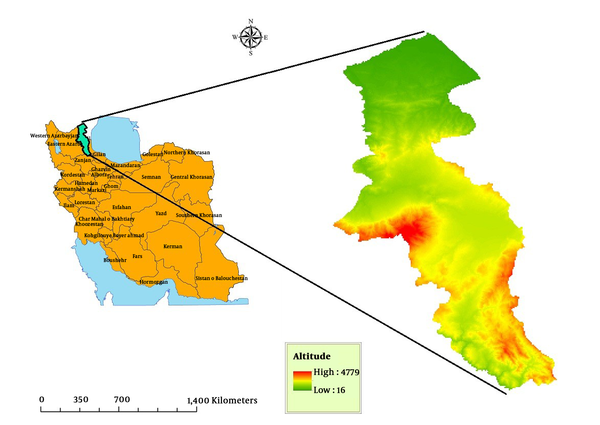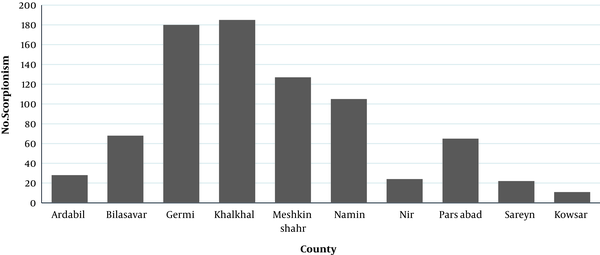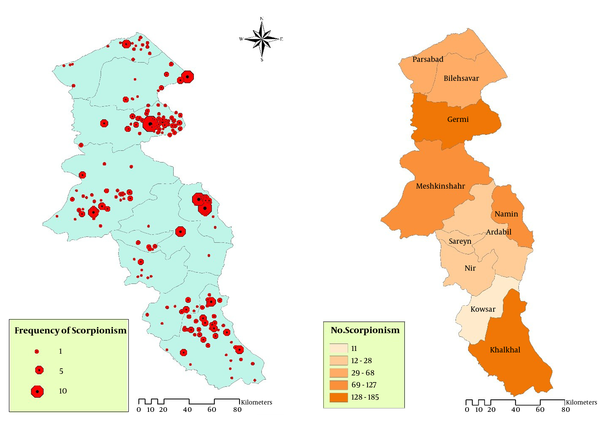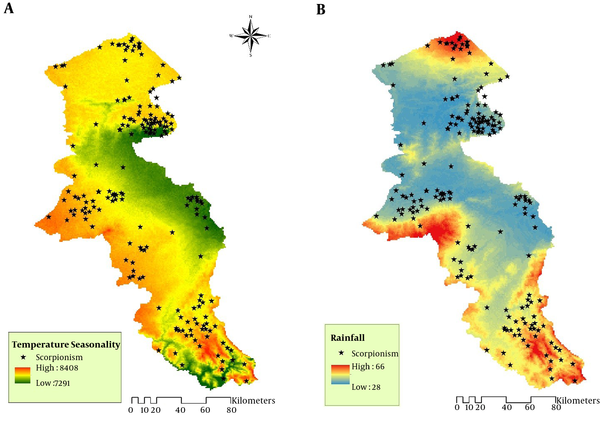1. Background
Annually, over one million scorpion stings occur in the world (1, 2). Scorpion sting is one of the health threatening problems and 36,000 cases are reported in Iran per year (3). Most of the scorpion sting victims are children. Approximately, the mortality due to the scorpion stings is annually more than 3250 cases in the world, and less than 20 human cases in Iran (4). Scorpion belongs to phylum Arthropoda and class Arachnida and to date 16 families of scorpions are identified worldwide (5, 6). There are three families of scorpions in Iran: Buthidae, Hemiscorpiidae, and Scorpionidae; 1500 species of scorpions are identified in the world of which 50 species are dangerous to humans (7); 23 genus and 44 species are identified in Iran. It is reported that most of the scorpions are scattered in Southern, and Southwestern areas of Iran, and the maximum variation of the scorpions are reported in Khuzestan Province with 19 out of 59 identified species (3, 8, 9). Four scorpion species are scattered in Azerbaijan regions, including Compsobuthus matthiesseni, Mesobuthus caucasicus, Orthochirus Scrobiculosus, and Scorpio maurus Linnaeus (1758) and in Ardabil regions two species were identified: Mesobuthus eupeus and Andrectonus crassicauda (10, 11). Scorpion sting occur in all regions of Iran. There is no complete definition of scorpion sting epidemiology and clinical signs in Iran (12, 13). However, the clinical symptoms of scorpion sting are different depending on the species: The amount of toxins entering the body, the season of the sting, and age and physical condition of the injured person (14, 15). Geographical information system (GIS) is a powerful tool for the epidemiological surveillance, management, and analysis of many health problems information (16). GIS can analyze the information and distribution rate of the disease in the spatial maps. GIS is very useful to manage, allocate resources, and monitor diseases in high-risk regions (17). The current study aimed at investigating scorpion stings, determining the distribution, and analyzing its spatial status in Ardabil Province to control, survey, and manage scorpion stings by GIS in the North-West of Iran.
2. Methods
2.1. Study Area
Ardabil Province is located in the North-West of Iran. This area is 17,953 km2 and according to the 2015 census, its population was 1,249,000 people. This province has 10 counties and 1477 permanent villages (Figure 1).
2.2. Data Collection
In the current cross sectional study, all information about scorpion stings in all of the counties in Ardabil Province including: Kowsar, Sareyn, Parsabad, Nir, Namin, Meshkin-shahr, Khalkhal, Germi, Bilasavar, and Ardabil were recorded from 2012 to 2017. In the current study, a researcher-made questionnaire was employed to collect the demographic and epidemiologic data. The questionnaire was designed based on variables such as the site of the bite, age and gender of the victim, season, injured limb, village, and location of incidence. The routine human scorpion stings information were collected from health houses, healthcare centers, and hospitals in standard epidemiological surveillance forms designed by Center for Disease Control and Prevention (CDC), Ministry of Health and Medical Education (Iran). The data were provided to the Department of Diseases Prevention and Control, Provincial Healthcare Center in Ardabil, North-West of Iran.
2.3. Ethical Considerations
The current study was approved by the Ethics Committee of Ardabil University of Medical Sciences (ethical code: IR.AUMS.REC.1395.21).
2.4. Inclusion and Exclusion Criteria
The current study only included the patients' data collected in standard epidemiological surveillance forms and scorpionism characteristics confirmed by physician that were treated with anti-scorpion venom serum provided by the CDC of Ministry of Health. Other victims were not entered into the current study.
2.5. Statistical Analysis
Arc GIS 10.2.3 was employed to draw spatial distribution maps of high-risk areas for scorpion stings. In addition, meteorological data such as relative humidity, annual temperature, rainfall, sunny days, and frost days were obtained from Ardabil Meteorological Office. Separately, variables such as the site of bite, age and gender of the scorpionisms, season, injured limb, rural or urban areas, the mean annual temperature, relative humidity, and altitudes were also analyzed. Unadjusted linear regression and correlation coefficient were used to analyze data with SPSS version 19 in order to find the effect of climatic factors on spatial distribution of scorpion stings.
3. Results
Totally, 815 scorpionism cases were recorded of all counties of Ardabil Province during the study period; 56.5% of the cases were male and the rest (43.5%) were female. most of the scorpion sting victims (42%) were within the age range of 11 to 30 years and the age range of 70 and above constituted the least cases (19%); 61% of scorpionism cases occurred indoors and 39% outdoors. Hands and feed were the most injured organs (85%); 97% of the victims received anti-scorpion venom serum both intramuscularly and intravenously; 94% of the victims were the new cases and 6% had a history of scorpionism; 87% of scorpions were yellow, 7% dark, and 6% were not identified.
The highest incidence rate of scorpion sting was in 2017 (16.32/100,000) and the lowest in 2012 (5.45/100,000) (Table 1). The scorpion sting peak occurs from August to July and the lowest burden is observed in January and December (Table 2 and Figure 2).
| Year | Incidence Rate of Scorpionism | Average Temperature, °C | AAMTa, °C | AAMTb, °C | Average Humidity, % | TAPc, mL | ANFDd, d | Average Air Pressure, QFEe |
|---|---|---|---|---|---|---|---|---|
| 2012 | 5.45 | 10.58 | -18.50 | 33.50 | 65.30 | 386.15 | 93.50 | 870 |
| 2013 | 10 | 11.25 | -17.85 | 34.72 | 64.25 | 375.62 | 90 | 881 |
| 2014 | 9.53 | 12.29 | -13.96 | 37.59 | 63.25 | 368.68 | 84.70 | 890 |
| 2015 | 8.81 | 12.58 | -12.48 | 38.12 | 61.98 | 304 | 82 | 895 |
| 2016 | 14.58 | 13.56 | -11.30 | 39.10 | 61.5 | 301.85 | 80.2 | 899 |
| 2017 | 16.32 | 13.59 | -11 | 39.20 | 61.43 | 301.15 | 80 | 899 |
The Incidence Rate of Scorpionism per 100,000 Cases and Association with Climatic Variables
| Month/Year | Mar. | Apr. | May | Jun. | Jul. | Aug. | Sept. | Oct. | Nov. | Dec. | Jan. | Feb. | Annual |
|---|---|---|---|---|---|---|---|---|---|---|---|---|---|
| 2012 | 4 | 7 | 12 | 10 | 15 | 14 | 4 | 1 | 1 | 0 | 0 | 0 | 68 |
| 2013 | 1 | 7 | 24 | 21 | 27 | 30 | 13 | 2 | 0 | 0 | 0 | 0 | 125 |
| 2014 | 6 | 6 | 6 | 20 | 49 | 14 | 10 | 4 | 3 | 0 | 0 | 1 | 119 |
| 2015 | 4 | 11 | 12 | 18 | 46 | 10 | 4 | 2 | 1 | 0 | 0 | 2 | 110 |
| 2016 | 4 | 7 | 12 | 30 | 50 | 34 | 25 | 10 | 4 | 3 | 2 | 1 | 182 |
| 2017 | 6 | 10 | 15 | 33 | 56 | 39 | 28 | 12 | 5 | 3 | 3 | 1 | 211 |
| Total | 25 | 48 | 81 | 132 | 243 | 141 | 84 | 31 | 14 | 6 | 5 | 5 | 815 |
| Mean | 4.17 | 8 | 13.5 | 22 | 40.5 | 23.5 | 14 | 5.17 | 2.33 | 1 | 0.83 | 0.83 | 135.83 |
| SD | 1.83 | 2 | 5.92 | 8.36 | 15.9 | 12.3 | 10.33 | 4.66 | 1.96 | 1.54 | 1.32 | 0.75 | 51.86 |
| Average temperature °C | 9.25 | 15 | 19 | 22 | 22.25 | 21 | 15.75 | 9 | 4.5 | 3 | 2.5 | 6 | 12.43 |
| Average relative humidity, % | 65 | 60.75 | 55.5 | 54 | 50 | 58.5 | 65.5 | 73 | 72.25 | 63.5 | 68 | 68.5 | 62.87 |
The Trend of Scorpionism in Ardabil Province; North-West of Iran from 2012 to 2017
Spatial distribution of scorpionism revealed that most of the cases were reported from Khalkhal (22.69%), the Southern mountainous areas of the province with lower temperature, higher altitude, and higher rainfall in comparison with other counties as well as Germi (22%), located in the Northern areas of the province. The lowest cases belonged to Kowsar (1.35%) and Nir (2.94%) counties with semi-mountainous areas (Figures 3 and 4).
The important environmental factors that affected the scorpion stings in Ardabil Province were temperature and seasonal rainfall (Figure 5). The maximum average annual temperature was recorded in 2017 (13.59°C) and lowest annual average humidity was recorded in the same year with 61%. The minimum average annual temperature (10.58°C) with the highest annual average humidity (65.3%) was recorded in 2012. From 2012 to 2017, the average total rainfall 85 mm decreased, and the minimum and maxium average temperatures respectively 2.7 and 4.6°C increased.
The unadjusted linear regression showed significant relationship between scorpion stings and some of the climatic factors, significant relationship among average, maximum, and minimum temperatures and average sunny days. Also, direct significant relationship was observed between the increase of temperature and the number of sunny days during the period of scorpion sting increase (P < 0.05).
Relationship between average relative humidity (RH) and rainfall was indirect, that means with decreased RH and rainfall, the scorpionism rate increased (P < 0.05) (Table 3). The number of frost days during the seven years of study decreased 13.3 days. The average air pressure (QFE) in different years were rising (Table 1)
| Independent Variable | Unstandardized Coefficient | Standardized Coefficient | t | P Value | |
|---|---|---|---|---|---|
| B | Std. Error | Beta | |||
| Average temperature | 6.432 | 1.131 | 0.874 | 5.685 | 0.0001 |
| Maximum temperature | 5.668 | 1.175 | 0.836 | 4.824 | 0.001 |
| Minimum temperature | 6.674 | 1.267 | 0.857 | 5.267 | 0.0001 |
| Average sunny days | 0.743 | 0.137 | 0.863 | 5.412 | 0.0001 |
| Average relative humidity | -6.575 | 1.29 | -0.85 | -5.098 | 0.0001 |
| Average rainfall | -2.479 | 1.076 | -.589 | -2.303 | 0.044 |
The Results of Unadjusted Linear Regression Between Scorpionism and Some Climatic Factors in Ardabil Province; North-West of Iran From 2012 to 2017
4. Discussion
Ardabil Province is located in a temperate region in North-West of Iran. According to the increasing average global temperature and its impact on insects' lives, the incidence of scorpionism in such areas is increasing; therefore, the average annual temperature increase from 2012 to 2017 was 3°C. In addition, the prevalence of scorpionism increased to 10.87 per 100,000 people that means it increased more than three times. This increase is a health threat in this area, since with the increase of temperature and decrease of humidity, the prevalence of scorpionism increased. In Hormozgan Province, South of Iran (18), Morocco (19), and Brazil (20) scorpionism also increased. More than 70% of the cases occurred in June, July, and August. Scorpion stings mostly occurred in hot months. In Ardabil Province, the average temperature increased from 33.5°C in 2012 to 39.2°C in 2017; furthermore, average absolute minimum temperature decreased from -18.5 to -11. Therefore, these climatic changes and increase in the minimum absolute and maximum temperatures during the cold and hot months of the year increased the activity of scorpions. Most of the scorpionism victims in the current study were male that was consistent with the studies by Nejati et al. (21) and Daneshi et al. (22). The age range of 20 to 40 years constituted most of the victims, since this age group is usually the active labor force who are more exposed to scorpions. Most of the damaged organs were hands and feet; this result is in agreement with those of the studies by Isazadehfar et al. (23) and Mohammadi et al. (24). Most cases occured indoors, which showed the high density of scorpions in housing in this area. However, results of the current study were inconsistent with those of Nejati et al. (21), since in their study most cases occurred outdoors. Results of the current study showed that all of the victims improved and no mortality was reported. Therefore, the venom of scorpion species in Ardabil Province is less toxic. More than 97% of victims in the current study received anti-scorpion venom serum, while it was 99% in the study by Karimi with 0.3% mortality (25); 87% of the scorpions in the current study were yellow and 7.28% were black, but in the studies by Rafizadeh et al. (26) and Hosseininasab et al. (27) the scorpions were mostly yellow. However, a thorough study of scorpion fauna in Ardabil Province seems essential. According to the distribution map, most of the scorpionism cases occurred in two counties of Khalkhal and Germi; since these regions are the high-risk foci, supply of anti-scorpion venom serum is essential and people in these regions should be educated to control and prevent scorpion stings. Global warming and climatic change in all areas of the world caused temperature increase during 2012 to 2017; the average temperature in Ardabil Province increased more than 3°C that had a direct impact on the increase of scorpionism and the prevalence of scorpionism also increased more than 2.5 times. Other factors associated with the increase of scorpionism in this area include reduction of the relative humidity, the lower total annual rainfall, and increase of the minimum absolute and maximum temperatures. The hot zones of scorpionism were in the Northern (Germi) and Southern (Khalkhal) regions of the province. Results of the current study could be applied to determine and map high risk foci of scorpion stings areas, plan for training programs to prevent the occurrence of scorpionism by the health care system, and suitably distribute the relevant anti-scorpion venom serum and other therapeutic requirements according to high-risk areas. Some of the limitations of the current study were illegible and incomplete forms, which were excluded and difficulty to extract data from the hospital archives. Field studies should be conducted to identify the dangerous scorpions species in the region. Also, studies with different health education models should be conducted to promote awareness of at risk people and prevent scorpionism.
4.1. Conclusion
According to the current study results, there were two hot zones for scorpion sting in Ardabil Province, one of them was Khalkhal County in the Southern mountainous areas of the province with lower temperature higher altitude, and high rainfall, in comparison with other counties; and the other one was Germi County located in the Northern areas of the province. In addition, due to the coincidence of temperature increase and reduction of rainfall and humidity with the increase of scorpionism, it is expected that the increase of temperature in the next years with regard to the global warming phenomenon, affects the prevalence of scorpionism in the studied province.




